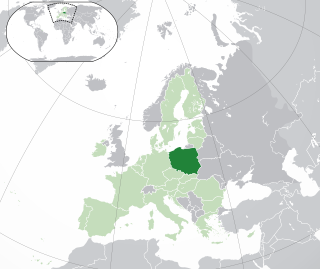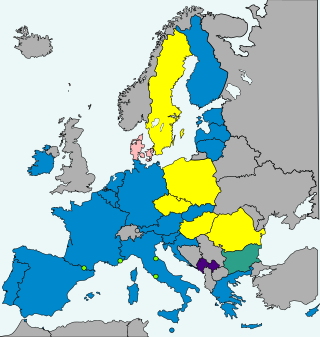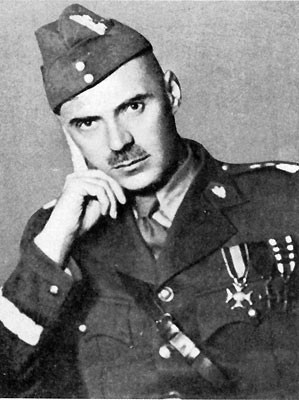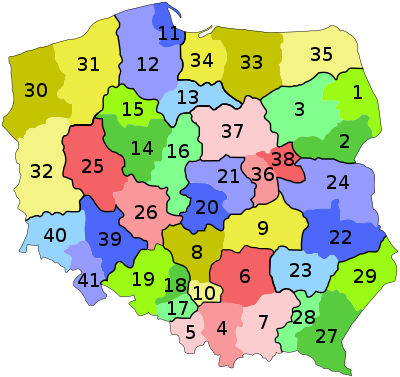
Supraśl is a town and former episcopal see in north-eastern Poland.

Stefan Wyszyński was a Polish prelate of the Catholic Church. He served as Bishop of Lublin from 1946 to 1948, Archbishop of Warsaw and Archbishop of Gniezno from 1948 to 1981. He was created a cardinal on 12 January 1953 by Pope Pius XII. He assumed the title of Primate of Poland.

Poland does not legally recognize same-sex unions, either in the form of marriage or civil unions. In 2012, the Supreme Court ruled that same-sex couples have limited legal rights in regards to the tenancy of a shared household. A few laws also guarantee certain limited rights for unmarried couples, including couples of the same sex. Same-sex spouses also have access to residency rights under EU law.

Lesbian, gay, bisexual, and transgender (LGBT) people in Poland face legal challenges not experienced by non-LGBT residents. According to ILGA-Europe's 2023 report, the status of LGBTQ rights in Poland is the worst among the European Union countries.

Poland does not use the euro as its currency. However, under the terms of their Treaty of Accession with the European Union, all new Member States "shall participate in the Economic and Monetary Union from the date of accession as a Member State with a derogation", which means that Poland is obliged to eventually replace its currency, the złoty, with the euro.

The Catholic Church in Lithuania is part of the worldwide Catholic Church, under the spiritual leadership of the Pope in Rome. Lithuania is the world's northernmost Catholic majority country. Pope Pius XII gave Lithuania the title of "northernmost outpost of Catholicism in Europe" in 1939.

The Ukrainian (Greek) Catholic Eparchy of Wrocław–Koszalin is a suffragan eparchy in the ecclesiastical province of the metropolis of Przemyśl-Warsaw, which covers some part of Poland for the Ukrainian Greek Catholic Church parallel to the Latin hierarchy. It depends from the Roman Congregation for the Oriental Churches.

Religion in Poland is rapidly declining, although historically it had been one of the most Catholic countries in the world.

The Ukrainian Catholic Archeparchy of Przemyśl–Warsaw is an ecclesiastical territory or ecclesiastical province of the Ukrainian Greek Catholic Church — a particular Eastern Catholic Church, that is located in the south-eastern part of Poland. It was erected in 1996. Its Byzantine Rite services are conducted in the Ukrainian language. As a metropolitan see, it has two suffragan sees: Olsztyn–Gdańsk and Wrocław-Koszalin. The incumbent ordinary of the archeparchy is Eugeniusz Popowicz. It is assisted and protected by the Dicastery for the Eastern Churches in Rome. The cathedral church of the archeparchy is the Cathedral of St. John the Baptist, in the city of Przemyśl. Although the national capital of Warsaw was added to its title, there is no co-cathedral.
Abortion in Poland is illegal except in cases where the pregnancy is a result of a criminal act or when the woman's life or health is in danger. The last change in the Act on Pregnancy Planning of the Republic of Poland took place on 27 January 2021, when publication of the judgment of the Polish Constitutional Tribunal in the Dziennik Ustaw RP took place.

The Society of Christ for Polish Migrants, abbreviated S.Chr. and also known as the Chrystusowcy, is a Catholic clerical religious congregation of pontifical right for men founded August Hlond and Ignacy Posadzy on August 8, 1932.

Atheism and irreligion is uncommon in Poland with Catholic Christianity as the largest faith. However, it is on the rise, which has caused tensions in the country. According to a 2020 CBOS survey, non-believers make up 3% of Poland's population.

Kazimierz Romaniuk is a Polish Catholic prelate, and professor of biblical studies. In 2004, Romaniuk became the bishop emeritus of the diocese of Warszawa-Praga. He was previously the rector of the Higher Metropolitan Seminary and the Academic Study of Catholic Theology in Warsaw, the auxiliary bishop of Warsaw, and the diocesan bishop of Warsaw-Praga.

Jan Krzysztof Żaryn is a Polish historian, professor and politician, who was a Senator in the Senate of Poland from 2015 to 2019.

The Most Holy Virgin Mary, Queen of Poland is an honorary title for Mary, mother of Jesus, used by Polish Catholics.

The 2020–2021 women's strike protests in Poland, commonly called the Women's Strike, were anti-government demonstrations and protests in Poland that began on 22 October 2020, in reaction to a ruling of the Constitutional Tribunal, mainly consisting of judges who were appointed by the ruling Law and Justice dominated United Right, which tightened the law on abortion in Poland. The ruling made almost all cases of abortion illegal, including those cases in which the foetus had a severe and permanent disability, or an incurable and life-threatening disease. All-Poland Women's Strike was charged by the authorities for having illegally organised the protests.

In Polish culture, the True Pole is a stereotype of an ideal Polish person. This stereotype is closely associated with Polish Catholicism. The "true Pole" expression is often invoked in Polish right-wing and nationalist rhetoric.

The Ukrainian (Greek) Catholic Eparchy of Olsztyn–Gdańsk is a suffragan eparchy in the ecclesiastical province of the metropolis of Przemyśl-Warsaw, which covers some part of Poland for the Ukrainian Greek Catholic Church parallel to the Latin hierarchy. It depends from the Roman Congregation for the Oriental Churches.

A Polish withdrawal from the European Union, or Polexit, is the name given to a hypothetical Polish withdrawal from the European Union. The term was coined after Brexit, the process of Britain's withdrawal from the EU which took place between 2016 and 2020. Opinion polls held in the country, between 2016 and 2021, indicated majority support for continued membership of the European Union (EU). A 2022 survey indicated that "[at] least eight-in-ten adults in Poland" believed that the EU "promotes peace, democratic values and prosperity". The 2023 Polish parliamentary election was won by a coalition of predominantly pro-EU parties.
Marian Kałuski - Polish-Australian journalist, writer, historian and traveler.























